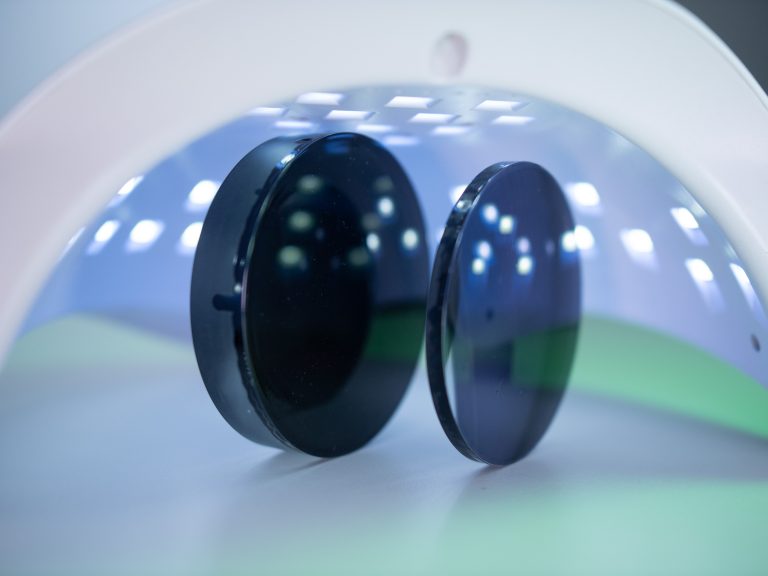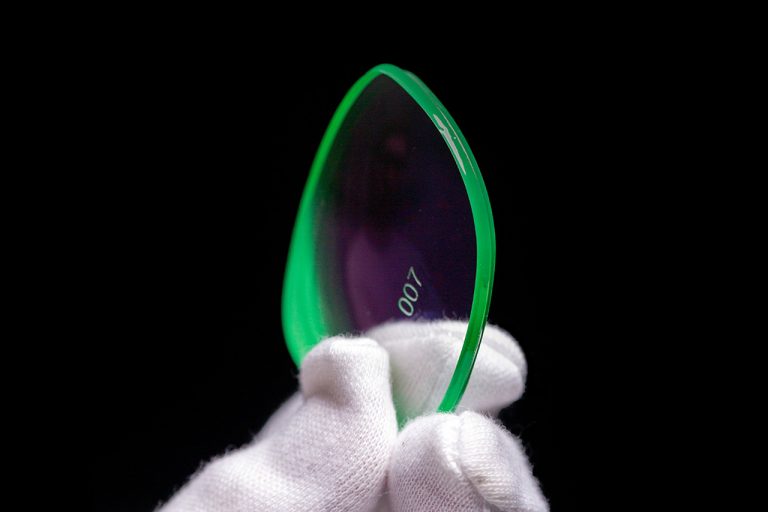The history of ColorMatic

A state-of-the-art technology for photochromic lenses
Photochromic lenses by Rodenstock have a very long history. For more than 55 years now, the product has been continuously improved. The primary development goals were always the same: rapid reaction kinetics in lightening and darkening, an almost transparent lens indoors and a comfortably darkened lens in the sunshine. Thanks to an innovative compound technology, the lenses are now almost perfect and exactly at this high level the company has taken a surprising step. From now on, independent lab partners will have access to the ColorMatic technology as well as to ColorMatic as an independent technology brand.
Photochromic lenses since 1960
Self-tinting lenses have the spectacular property of changing their light absorption evenly and reversibly depending on the sunlight intensity. Starting from a highly transparent basic state, they darken when exposed to sunlight and lighten up again with decreasing sunlight, returning to their original state.
The first photochromic lenses were developed in the 1960s using mineral glass by two American chemists, Stanley Donald Stookey and William Armistead. Recognizing the comfort this technology offered to spectacle wearers, Rodenstock, a pioneer in the field, introduced them to the European market in 1968 as the first European lens manufacturer.
While the desire for even greater comfort using lighter plastic lenses was already apparent, the production process used for mineral glass could not be directly transferred to plastic lenses.
The first generation of phototropic plastic lenses from Rodenstock was introduced as “ColorMatic” on the market in 1986. Ever since, generations of dedicated scientists at Rodenstock have been working on further improving this first generation. Properties like darkening depth, fading speed and stability have been successively improved.
The goal was and still remains to offer the best possible performance and quality to spectacle wearers. Therefore, Rodenstock continued to question their products, to push boundaries, change paradigms and maintain their good market position.
The functionality of photochromic lenses
As is widely known, photochromic molecules in the lens react to UV radiation. Indoors, they maintain a closed structure, allowing visible light to pass through the lens unhindered. When exposed to sunlight, the photochromic molecules react and change their structure. They unfold, the changed structure absorbs more visible light, thereby reducing transmission. The lenses darken.
If the intensity of UV radiation decreases, for example due to cloud cover, the molecules partially close again. The lens becomes semi-transparent. If UV radiation no longer impacts the lens, the photochromic molecules return to their initial state, allowing visible light to pass through. The lens becomes clear again.
The photochromic technology of ColorMatic
As one innovation leader for photochromic lenses, Rodenstock is constantly setting new standards in quality, speed and stability with its own research and development department. With a clear focus on innovation, the pioneering work in this area is reflected in a track record of over 80 patents.
ColorMatic is a high-performance technology for photochromic lenses offering protection against harmful UV light and reducing blue light and glare. For light-sensitive spectacle wearers in particular, it offers relaxed vision thanks to tinting in appropriate light conditions.
Since the first product generations, rapid reaction kinetics in lightening and darkening has been a primary development goal for all Rodenstock photochromic products. Thus ColorMatic offers outstanding vision clarity and performance across all refractive indices and materials, as well as high lightening speed in all climates and throughout all seasons, 365 days a year.
This greatly improved reaction kinetics, coupled with consistently stable photochromic performance and UV protection, is achieved by technology.
A conventional approach to improving kinetics would involve designing the polymer matrix (the plastic material surrounding the dyes) to be more flexible. However, a very soft matrix is not compatible with high mechanical stability requirements.
The latest generation for best performance
With ColorMatic X, Rodenstock is taking a different approach: Rodenstock has taken their latest dye generation and embedded it in a durable optical high-index matrix. However, the dye’s surroundings have a different flexibility. Additional degrees of freedom regarding optical properties and UV protection are generated by the compound technology, which separates the function of phototropism from the optical and mechanical properties of the lens.
Full UV protection is ensured by the superior base lens. The lens can thus change from the darkened state to the colorless state at an accelerated rate – 54% faster than the previous generation. In doing so, the lenses achieve a base transmittance of up to 95%, meaning they are hardly distinguishable from conventional lenses indoors, making them currently the clearest photochromic lenses on the market.[1]
The lightening time is a crucial factor for phototropic lenses because faster lightening means a seamless viewing experience for the wearer. Another advantage is that the lenses darken by up to 88% outdoors, providing the wearer with comfortable vision and protection in changing light conditions and bright sunlight.
ColorMatic as an independent technology brand
To emphasize this outstanding technology, Rodenstock is taking a decisive further step and positioning ColorMatic as an independent technology brand with its own brand design, thus giving independent lab partners access to the ColorMatic technology and brand.
The positioning as an independent brand demonstrates the company’s ongoing commitment to innovation and product development and represents Rodenstock’s high-quality photochromic technology with its own brand design. The recently introduced hexagon logo stands for a photochromic molecule that represents the technology through a color gradient. The associated tagline “Engineering photochromic performance” refers to the outstanding in-house expertise and the endeavor to redefine the limits in terms of performance and speed.
References
[1] Based on internal data on index 1.60

Franz-Josef Achatz
Franz-Josef Achatz is a Senior Manager in the Global Product Management Lenses at Rodenstock. With his passion for strategy and innovation management in the field of ophthalmic lenses, he focuses on the development and marketing of photochromic products, among other things.







